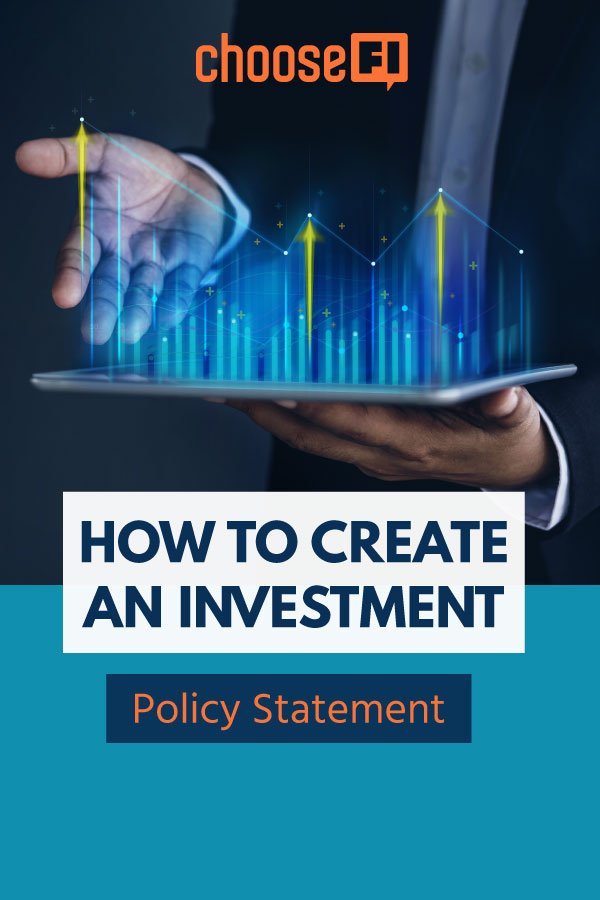As members of the FI community, our goals are all similar enough. In order to retire early, we need to have 25x our annual expenses in diversified investments and savings to achieve this. But how and when each one of us achieves it may be completely different based on our individual scenarios, which is where having an Investor Policy Statement comes in handy.
Table of Contents
- What Is An Investment Policy Statement
- Why An Investment Policy Statement Is Important
- Questions To Answer Before Writing Your Statement
- Creating An Investment Policy Statement
- Resources
What Is An Investor Policy Statement
Basically, an Investment Policy Statement (IPS) is the framework of your investment plan. Traditionally, this is a statement created by a fund manager for their clients. It tells the investors what the money manager will do with the money. How much they will invest in different asset classes as well what will trigger a sale. But you can do this for yourself, as you are both fund manager and client.
The IPS is your guideline designating how you want to structure your investment plan prior to retirement and then how you plan to utilize the funds afterward. In order to write one, you need to know what your retirement goals are, how much money you need to meet those goals, and where all of your current investments are. Once you have all of that information, you can begin to create your Investment Policy Statement.This may sound like a big undertaking, but it can be as simple–or as complicated–as you want it to be.
Why An Investor Policy Statement Is Important
Having a plan is a big deal when it comes to investing. Sitting down and making a rational and logical plan will help us weather the storms that are sure to come. After all, we tend to get emotional when our money is involved, even the most stoic of us.
Planning out what you will do in different circumstances will help you not make knee-jerk decisions during difficult times. It will keep you in the market when it dips so you aren’t selling at the bottom, and it will help you keep your head when a certain asset class skyrockets. Bitcoin anyone? It’s hard not to jump on the investing bandwagon when you are hearing stories of people becoming millionaires overnight. But an IPS will help you stick to your plan and not get caught up in the hype.
An investment policy statement will be your guiding light when the markets do something you aren’t expecting.
Questions To Answer Before Writing Your Statement
Before you can begin to structure your Investment Policy Statement, you will need to answer a few questions regarding your proposed retirement. If you are retiring with a spouse, then you will both need to answer these questions together to get on the same page.
- How old do you want to be when you reach FI?
- How much money do you need annually to live on comfortably?
- What are your short term financial goals and can any of those be modified to accelerate the FI process and increase your long term financial stability?
- How quickly can you pay off your student loans? What does the action plan look like for that to be completed prior to reaching FI?
- Once you have the student loans paid off, where will you be allocating the money you had been using to pay them?
- What are your plans for retirement? Do you plan to work part-time, travel, volunteer, etc?
- Where are your investments currently located?
- How much are you currently contributing to which investment accounts?
- What should you change your contributions to in order to maximize their potential and retire earlier?
- What are your target allocation and types of funds that you want to invest in?
- Which investment accounts should you use during drawdown for early retirement to create the best tax benefits for you?
- What is your proposed plan in case of divorce? Even if you don’t want to think about it, divorce happens, so it is better to be prepared for the worst-case scenario.
- What reasons, if any, would you consider changing your IPS?
These are just the basic jumping-off points, questions that you need to ask yourself before you can even begin putting an IPS together. But once you have the answers to these questions, then the real fun begins!
Creating An Investor Policy Statement
Finding the answers to the aforementioned questions might easily be the most difficult part of the whole process. Sitting down to put everything down on paper or in a Word document is the easy part.
Remember that if you’re married, you should be doing all of this together with your spouse. That includes both answering the questions and writing the IPS. You should both agree with what’s in the final document.
Here is a rough example of what an IPS could look like:
Objectives
- Retire by age 50–empty nester
- Travel the world, volunteer our time helping in the food/agriculture industries, write about experiences
- Have an annual income of $60,000 after taxes, in today’s dollars, from our investments
- Minimize our tax liabilities
- Have mortgage and any other student loans paid off in full prior to reaching FI
- Once mortgage and student loans are paid off, put 50% into diversified investments and 50% into purchasing more real estate for passive income in retirement
Diversification & Risk Tolerance
- Our risk tolerance is currently high to maximize potential future growth
- Anticipate a withdrawal rate of 4% maximum
- Don’t try to beat market returns–just let the market do what it will and rebalance monthly
- Use mostly passive investment options
- Invest in more real estate to increase the diversification of our portfolio
Asset Allocation
- 50% total allocations in buy and hold real estate
- 40% total allocations in diverse investment funds, broken down as follows:
- 65% US Stocks–small-cap and mid-cap primarily for potentially larger overall returns
- 15% International Stocks–10% Developed International and 5% Emerging International
- 14% Bonds
- 6% REITs
- 10% total allocations in high-yield savings emergency funds
Related: Asset Allocation When You Plan To Retire Early
Drawdown Plan
- Use passive income to cover the first 50% of monthly expenses
- Sell shares from taxable accounts to cover 25% monthly expenses
- Take a distribution from IRAs to cover the remaining 25% of monthly expenses
- After 20 years, we will be 70 and can start taking Social Security, if it still exists
- If you have an HSA or SEPP, then use those funds interspersed with the taxable accounts and IRA distributions and change allocations accordingly
Review & Rebalancing
- Review how all assets are performing every quarter
- If asset allocations are off track by more than 5%, rebalance to get back on track
- No major changes should be made to the plan, but minor adjustments can be made annually, as the need arises (if married, changes need to be agreed to by both spouses)
Now that you have an idea as to what an IPS is, and what it can look like, it’s your turn to create your own.
Resources
- Morningstar has a set of directions and a worksheet that will walk you through setting up your own IPS.
- Investopedia has a good example of an IPS here
- Here’s what the Bogleheads have to say about an IPS, which includes an example of what they would include in an IPS.
Have you created an IPS? If so, what was your strategy and how has it helped you stay on track to reach FI?
Related Articles




